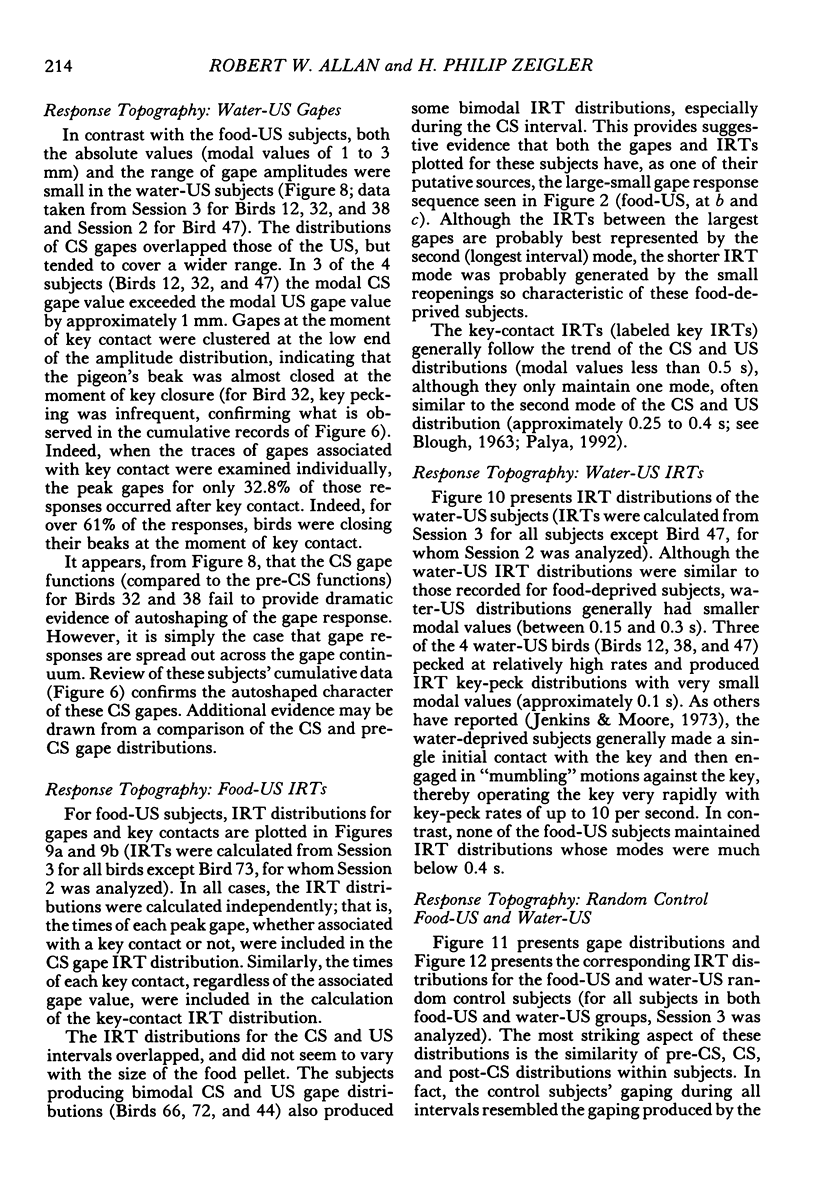Abstract
The pigeon's key-pecking response is experimentally dissociable into transport (head movement) and gape (jaw movement) components. During conditioning of the key-pecking response, both components come under the control of the conditioned stimulus. To study the acquisition of gape conditioned responses and to clarify the contribution of unconditioned stimulus (reinforcer) variables to the form of the response, gape and key-contact responses were recorded during an autoshaping procedure and reinforcer properties were systematically varied. One group of 8 pigeons was food deprived and subgroups of 2 birds each were exposed to four different pellet sizes as reinforcers, each reinforcer signaled by a keylight conditioned stimulus. A second group was water deprived and received water reinforcers paired with the conditioned stimulus. Water- or food-deprived control groups received appropriate water or food reinforcers that were randomly delivered with respect to the keylight stimulus. Acquisition of the conditioned gape response frequently preceded key-contact responses, and gape conditioned responses were generally elicited at higher rates than were key contacts. The form of the conditioned gape was similar to, but not identical with, the form of the unconditioned gape. The gape component is a critical topographical feature of the conditioned key peck, a sensitive measure of conditioning during autoshaping, and an important source of the observed similarities in the form of conditioned and consummatory responses.
Full text
PDF






















Selected References
These references are in PubMed. This may not be the complete list of references from this article.
- Bermejo R., Allan R. W., Houben A. D., Deich J. D., Zeigler H. P. Prehension in the pigeon. I. Descriptive analysis. Exp Brain Res. 1989;75(3):569–576. doi: 10.1007/BF00249908. [DOI] [PubMed] [Google Scholar]
- Blough D. S. Interresponse time as a function of continuous variables: a new method and some data. J Exp Anal Behav. 1963 Apr;6(2):237–246. doi: 10.1901/jeab.1963.6-237. [DOI] [PMC free article] [PubMed] [Google Scholar]
- Brown P. L., Jenkins H. M. Auto-shaping of the pigeon's key-peck. J Exp Anal Behav. 1968 Jan;11(1):1–8. doi: 10.1901/jeab.1968.11-1. [DOI] [PMC free article] [PubMed] [Google Scholar]
- Deich J. D., Houben D., Allan R. W., Zeigler H. P. "On-line" monitoring of jaw movements in the pigeon. Physiol Behav. 1985 Aug;35(2):307–311. doi: 10.1016/0031-9384(85)90354-3. [DOI] [PubMed] [Google Scholar]
- Jenkins H. M., Moore B. R. The form of the auto-shaped response with food or water reinforcers. J Exp Anal Behav. 1973 Sep;20(2):163–181. doi: 10.1901/jeab.1973.20-163. [DOI] [PMC free article] [PubMed] [Google Scholar]
- Palya W. L. Dynamics in the fine structure of schedule-controlled behavior. J Exp Anal Behav. 1992 May;57(3):267–287. doi: 10.1901/jeab.1992.57-267. [DOI] [PMC free article] [PubMed] [Google Scholar]
- Remy M., Emmerton J. Behavioral spectral sensitivities of different retinal areas in pigeons. Behav Neurosci. 1989 Feb;103(1):170–177. doi: 10.1037//0735-7044.103.1.170. [DOI] [PubMed] [Google Scholar]


